New York City: Asswipes Above, Asswipes Below
“With its sewer system under siege, tallying millions of dollars in equipment damage across its underground maze, New York City is confronting a menace that has gummed the gears of plumbing networks around the world: the common wet wipe. In recent years, the intersection of evolving hygienic sensibilities and aggressive industry marketing has fueled the product’s rise. Wet wipes, long used for baby care, have grown popular with adults…. The city has spent more than $18 million in the past five years on wipe-related equipment problems, officials said.” Also: “The dank clusters, graying and impenetrable, gain mass like demon snowballs as they travel.”
New York City, March 11, 2015

★★★★ Thin clouds and haze muffled the morning light. The atmosphere was cool like sweaty clothes after an otherwise refreshing nap. The Citi Bike racks were suddenly near empty. At the thought of canvas sneakers, that very model of canvas sneakers appeared through a shop window. A delivery cyclist cruised slowly around a corner, listening to a mechanical voice reciting directions as he went. The retreating snowbanks had revealed dog turds, a champagne cork, a bare rib bone. The golden Puck over the entrance of the Puck Building was dusty. A sax-and-drum combo competed with trees full of wildly twittering sparrows for sonic dominion over the mouth of the Columbus Circle station. Slush was still hanging on along the edge of Dante Square. Some of it was even whitish.
Why People Are Terrible On The Internet
“[S]ometimes, the stuff people do online is fake. We all suck at it, because ultimately, it is pretty dumb. You know that job where you teach people to be good at social media? Not real! Doesn’t exist. There is no being good at social media, because it is a horror show.”
— This woman is correct. No one is exactly who they pretend to be on the Internet, and if they say they are they are either fooling themselves or trying to cultivate simplicity and sincerity as their Internet brand. As terrible as everyone is in real life, they are exponentially worse online, where they are ostensibly able to direct their ideal presentation of themselves and still wind up looking like self-important dickfaces, especially the self-deprecating ones. Here is a good way of understanding how horrible “online” really happens to be: It is the one place in our world where the torrents of theoretical nonsense spouted about performativity actually make a small amount of sense, which goes a long way toward explaining why Twitter sometimes feels like a second semester torture chamber/critical theory tenure grab. Anyway, I want you to leave here armed with a semblance of hope rather than mired in a morass of despair, so I will tell you that there is one good thing about the way we’re all awful on the Internet: At least we’re faking it. See, you feel better now, right?
The American New York 'Times' Is the Plebeian New York 'Times'
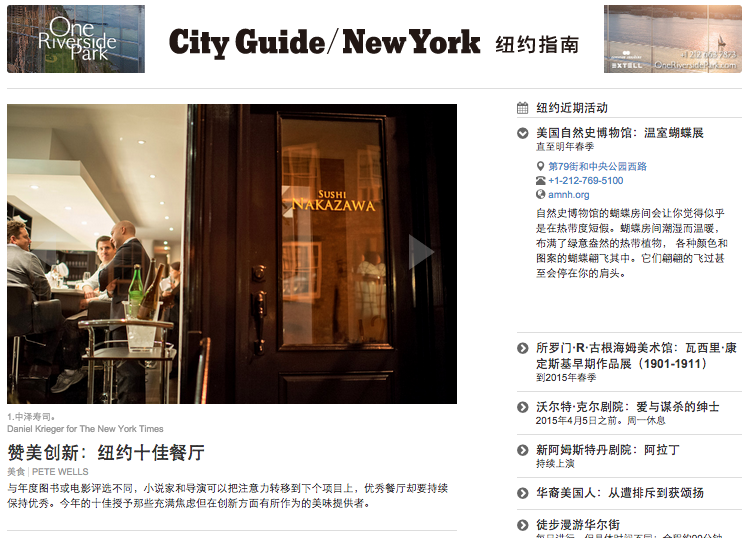
The New York Times today launched a Chinese-language print publication, City Guide/New York, with global distribution of 210,000 copies.
The first issue, Winter 2014/2015, was published on Dec. 1 and was distributed to travel agencies, hotels and airport lounges in Asia that cater to Chinese travelers bound for the United States as well as to hotels in New York City that have a substantial Chinese clientele. The Guide will also occasionally be inserted in the New York edition of The World Journal, the largest circulation Chinese-language daily in the United States.
“The print Guide is also accessible online through a responsive website, cn.nytguide.com,” the release says. So, how is the Times branding New York City for Chinese visitors? Let’s see which stories made the cut for translation.
1. Prized Performers: The 10 Best Restaurants of 2013. (The 2014 list was published in December)
Yes, the prices are dizzying, but so are the portions, the quality of the ingredients and the sheer exuberance of the preparations.
2. In 2013, the High End Ruled (December 2013)
In Midtown, where Central Park views authorize premium price points, 432 Park Avenue announced the signing of a $95 million contract for the top-floor penthouse, and at Extell Development’s juggernaut tower, One57, more than 10 condos priced above $45 million are under contract, two for more than $90 million. One57 is more than 70 percent sold, with total projected sales exceeding $2 billion.
At that rate, One57 appears to be positioning itself as next year’s “It” development. And if the avalanche of trophy contracts signed all over town in 2013 translate into closed sales, 2014 may well earn the sobriquet of the year of the splurge.
3. The Top 10 Items from Fall/Winter 2014 Men’s Trade Shows (January 2014)
Since 2012, the designers Aurélien Arbet and Jérémie Egry of Études have created men’s clothing that feels both Brooklyn-esque and French (which is not surprising since they’re based out of studios in Paris and the Brooklyn neighborhood of Greenpoint). This bold, cerulean cable-knit is easy to wear, and works year-round.
4. Art, and Handbags, for the People (July 2014)
H&M and Jeff Koons Collaborate on a Handbag
5. 36 Hours: Central Park, New York
6. A pair of T stories that I can’t seem to track down about runway fashion (November 2014)
The places guide is limited and particular:
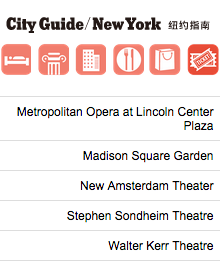

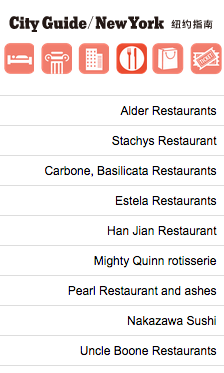
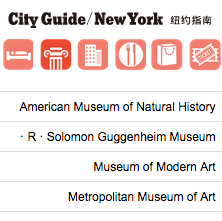

Especially the real estate section:

One Riverside Park, perhaps best known in the New York press for its “poor door,” makes quite a few appearances in this supplement! Its ads display on the front page of the site (in Incognito mode as well) and it is mentioned in the lead real estate story.
Elsewhere in the Times: Excellent coverage of the effects of international wealth on the New York real estate market!
By marketing the condos to wealthy foreigners, Time Warner’s developer was at the forefront of luring cash from overseas to New York real estate.
Is this useful as a guide? Maybe. An a exercise in self-branding? Definitely.
Champion the Match: Work vs. Soccer
by Awl Sponsors
Would you drop everything to fly to a Champions League Match in Barcelona? What if you had to convince your boss to go with you? See if these soccer fans can come away with a victory.
See more of the trip at www.Heineken.com/soccer
The Tenant Who Threatened to Sue the Landlord and Got His Rent Reduced
by Brendan O’Connor
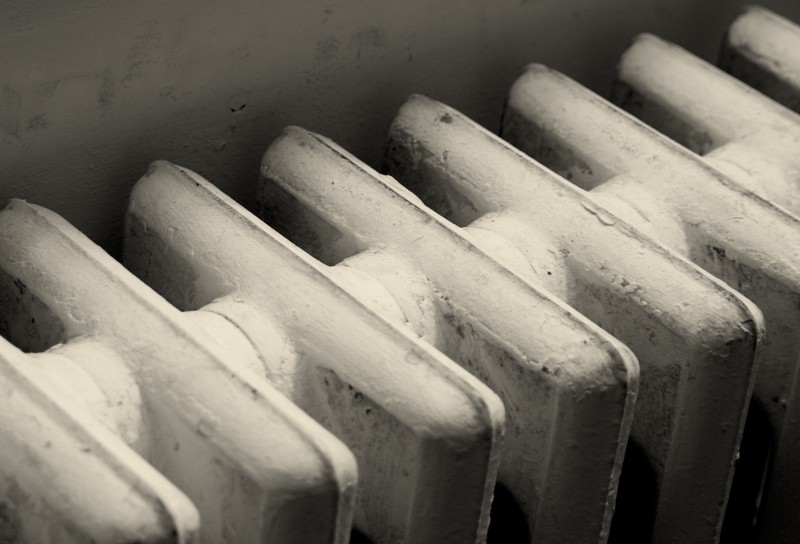
Welcome to Surreal Estate, a new column in which we will explore listings and stories from the tumultuous New York City real estate market.
Menahan Street and Myrtle Avenue
• $1,650/month
• Two bedrooms, one bathroom
• Nearest subway: L/M trains at Myrtle-Wyckoff Avenues
A little over a year ago, a young couple moved from California to Bushwick. They are, to use the verbiage of our day, “creatives”; he is a musician and she is a photographer. They pay the rent by laboring in the service industry. And they recently threatened to sue their landlord.
When they moved into the two-bedroom apartment — one bedroom has been converted into an office — mice and rats flowed from under the radiator. “I had to fight for that pretty hard,” the man, who did not want to be identified because the couple still lives in the same building with the same superintendent and the same landlord, told me. “First, I called the super. He put foam under the radiator, but they can eat right through it, so that didn’t really work.”
As predicted, the rats ate through the foam. The man called the super and insisted on a more permanent solution to the problem. “He was like, ‘Oh, I’m not able to do that this week. But next week!’” The man did not accept this. “I’m like, ‘Well, I’m gonna call the landlord if you can’t come this week, because we had a huge rat in our living room yesterday.” Article 151 of the New York City Health Code mandates that property owners are responsible for preventing and controlling “the harborage and free movement” of rats and other pests. After another week of calling, the super and the landlord came to the apartment, took measurements, and laid a grate down underneath the radiator. “Nothing’s gotten through since,” the man said.
One night last week, at around midnight — when it was still very, very cold — the building lost heat and power. It didn’t come back for three days. No other building on the block lost power. When the landlord wasn’t able to bring it back, the man called 311 “to find out what my rights are, what I could take him to court for.”
All New York City tenants in are entitled to both heat and hot water. According to the Housing Preservation & Development website, property owners are required to provide hot water (“at a constant minimum temperature of 120 degrees Fahrenheit”) year-round. Moreover, the period between October 1st and May 31st is referred to as “Heat Season.” During this time, property owners are required to fulfill the following conditions:
Between the hours of 6:00 AM and 10:00 PM, if the outside temperature falls below 55 degrees, the inside temperature is required to be at least 68 degrees Fahrenheit; and,
Between the hours of 10:00 PM and 6:00 AM, if the temperature outside falls below 40 degrees, the inside temperature is required to be at least 55 degrees Fahrenheit.
According to the HPD website, there have been nearly two hundred thousand heat complaints so far this Heat Season, up from over a hundred and eighty-one thousand last year. On January 8th, there were nearly fifty-three hundred complaints — the highest volume day this year. The good people on the other end of 311 told the man that his landlord was “in violation of several counts, including lack of repair and lack of code enforcement,” and that he was welcome to come down to the courthouse, pay a forty-five-dollar filing fee and initiate the complaint process against his landlord. “Most people probably don’t have time to do that,” the man said. He’s been working for a catering company, and work had been slow. “If I was working full-time those four days, there’s no way I could have taken care of it.”
Armed with knowledge of his rights, the man insisted that the landlord agree to a rent reduction, signed and in letter format, or else they would sue. Throughout this dispute, the landlord consistently deflected responsibility, the man said. “He was like, ‘Oh, it’s not my fault, you’re getting mad at the wrong person.’ I’m like, ‘Mmm, no. It’s your property, it’s your responsibility.” But, he told me, when Con Edison first came to the building they found a rat corpse and rat feces in the basement, “so that was a further delay on the process.” After three days, power was restored, and the landlord agreed to waive rent for the duration the building had gone without it.
The man believes that this landlord — and others like him — take particular advantage of tenants who either don’t know their rights or feel they cannot advocate for themselves. In his building, there are families who are recent arrivals to the United States, and for whom English is not their first language. “I think that he’s definitely preying on them, taking advantage of them,” he said. “It’s not right, and I’m so thankful that I’ve grown up in relative privilege and know what I can do and how to advocate for myself. But, you know, these families don’t know necessarily how to defend themselves.” Despite this deep and abiding concern for the rights of his fellow tenants, the man admitted that he only communicated with his downstairs neighbors during this situation.
The man and his fiancé are thinking about finding a new place to live, but moving is expensive. They seem resigned to their situation, for the short term, anyway. When I asked how they ended up in this apartment in the first place, he told me that when they moved to New York, neither of them had a job and were living off his savings while staying in an Airbnb. They found this place, and this landlord, and felt like he was helping them out by letting them sign a lease. “I don’t know if anybody else would have let us move in,” he said, referring to the fact that neither he nor his fiance had any proof of income at the time. “So that was nice of him, to do us that favor.”
Then, he added, “I guess we were sort of doing him a favor too, though, because he was charging us more for rent than anybody else in the building.”
Have you noticed a real estate listing that you would like to have investigated? Send cool tips, fun listings, and hot gossip to brendan@theawl.com.
Photo by Rebecca Smith
A Poem by Christopher Salerno
by Mark Bibbins, Editor
Cowboying
Someday your lasso will set up
as the mouth of hell and never shut.
A hole in the world’s topology.
Seen anyone coming? Note well
the anaphora of angry clouds
drifting along in the painted sky.
All vanishing points are indefinite.
To die is to have your shadow
removed from the desert floor forever.
Hell might seem overwhelming.
Because there is fire in our hearts
in hell there are probably nothing
but bellows. Great big ones.
On earth there are all the items
leftover from sagas: one is a flip-flop
floating on a puddle. Two is a piece
of tornado hail. Here is a rifle
to write with. We’ll be watching for
the westward trail of its smoke.
Christopher Salerno’s most recent book of poems, ATM, was selected by D.A. Powell for the 2013 Georgetown Review Poetry Prize. Previous books include Minimum Heroic (Mississippi Review Poetry Prize, 2010) and Whirligig (Spuyten Duyvil, 2006), as well as the chapbooks AORTA and Automatic Teller, winner of the 2013 Laurel Review Midwest Chapbook Prize.
Descriptions Of Extensively Aged Steak, Ranked By Rankness

9. “truffle, blue cheese and umami flavours”
8. “smells like roast beef when it’s raw”
7. “fatty, almost floral sweetness”
6. “buttery fat”
3. “chemical astringency”
2. “ripe cheesiness”
1. “mould blooms on the exterior fat”
Photo via Shutterstock
Man Takes Out Garbage
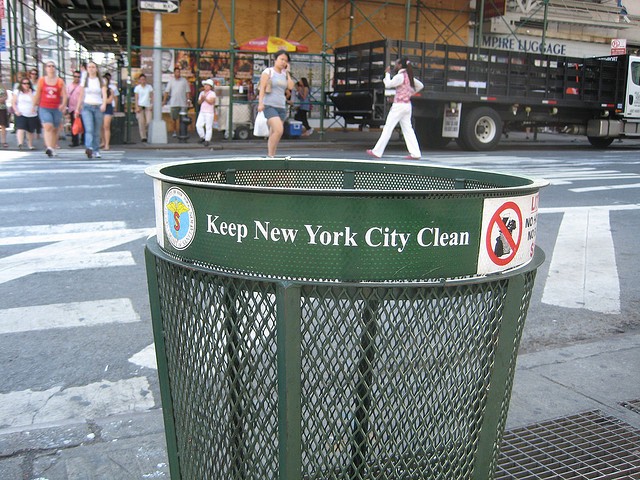
A friend called Mr. Groomes “a wonderful guy” and a regular neighbor. “If anybody would try to mess with his character, I would defend him on that,” the friend, Sikkim Assing, said. Ms. Assing, who is also a retired correction officer, said she understood why Mr. Groomes would want to have a gun permit. “A lot of people choose to carry a gun because we work with the garbage of New York,” she said. “We got to protect ourselves.”
William Groomes, the sixty-nine-year-old man who shot and killed Gilbert Drogheo, an unarmed thirty-two-year-old electrician, in the Borough Hall subway station using a nine-millimeter handgun that was lawfully carried with a concealed weapon permit, has been retired from the Corrections Department since 1993, meaning that he has not “work[ed] with the garbage of New York” in more than twenty years. While Drogheo’s co-worker, Joscelyn Evering, has since been charged with assault and menacing — Groomes was punched in the head, leading to what the Times characterizes as a “prolonged confrontation that spilled from subway car to platform to mezzanine” — and Groomes stated his intent to place the two under (citizen’s?) arrest after they got off the train, since neither was under the custody of the New York City corrections department at the time, it is unclear whether or not they would have qualified as “the garbage of New York,” requiring Groomes to protect himself in the estimation of a fellow corrections officer.
Under New York law, it’s permissible to use deadly force to counter a threat of similarly deadly force — after an attempt at retreat has been made. Groomes has not been charged with any crime, and according to the Times, “no decision had been made on whether to charge him.”
Photo by David Woo
